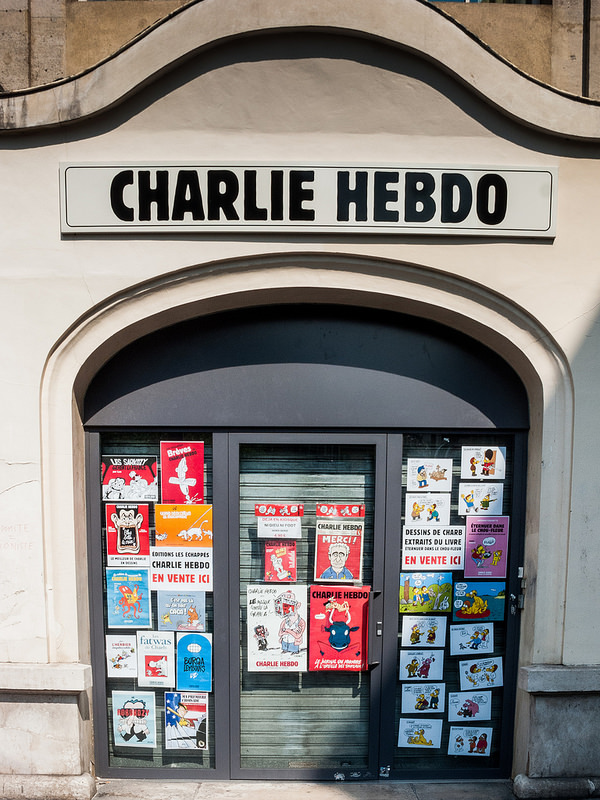I’m uneasy calling the massacre in Paris an attack on journalism. Journalism is a vast flabby entity, practised by many. The slaughter at Charlie Hebdo was aimed at satire, birthed along with journalism in the enlightenment era (Swift in England, Moliere and Voltaire in France, many others). More precisely, it was aimed at political cartooning, which the French adore. Daumier was the great precursor to the martyrs — I think that’s the right word — this week.
Cartoons are pure commentary, they contain no, or minimal, information. They’re unique in newspapers in that sense. Even movie reviews, which are meant to be opinion, convey lots of data: plot, cast, venue, etc. Cartoons aren’t sententious the way columnists are, cloaked in erudition and pseudo-evidence. It’s kind of amazing that they’ve survived in dailies at all, like refugees from 18th-century coffee houses. The cartoonist usually has no equivalents at the paper, he (or she) sits in an isolated space, he’s really a satirist employed by a newspaper.
I’m also uneasy with describing the work of these people as mockery (Doug Saunders in the Globe) or “the serious work of making fun” of fanaticism and “totalitarian ideologues” (Andrew Coyne in the National Post) or blasphemy (Ross Douthat in the New York Times). It makes them sound like precocious but limited adolescents venting their rage against authority. Basically a phase.
Their range is wider and their content more sophisticated. The three-word response of the Onion in the U.S. to 9/11 — Holy F—ing S— — laid over a graphic of the devastation, brilliantly foreshadowed all the counterproductive hysteria that followed: invasions, occupations, Abu Ghraib, reactions in the Muslim world, right down to Islamic State and the murders near the Place de la République this week.
Contributors to Charlie Hebdo held clear, passionate political views, many were “children of May 68,” explicitly left-wing or anarchist. For that reason they loathed the official “socialist” parties and often refused to vote in hollow elections. You can practically hear them weep in their 2013 response to charges of racism (reprinted in the Star).
They didn’t just hate fanatics and “despots” but also the respectable mindbenders of the church, “democratically” elected governments and the press itself. Charlie Hebdo extended its sympathy not just to Arabs and Muslims but even to Muhammad — he was a guest editor — for having to put up with the adoration of “idiots” (cons) like Islamic State and Al Qaeda.
In a way they and their cognates elsewhere carry the ethical burden of journalism (afflict the comfortable and comfort the afflicted) that mainstream media so often shuck. In the U.S. today the most insightful sources by far are Jon Stewart, Stephen Colbert and John Oliver. I know a teen addicted to them who resents the charge (which Stewart at least accepts) that they aren’t doing news, they’re doing comedy about the news. If there is a mix, it’s tending more toward the former, especially with Oliver’s brilliant Last Week Tonight.
If I’ve implied purity and uniformity on their part, je m’excuse. They grew up in the same society we all did and are susceptible to taboos and blind spots. In 2008, Charlie Hebdo management told the cartoonist Siné to apologize for anti-Semitism, on specious grounds. He said he’d rather cut his own balls off; they fired him and he sued the paper, winning a healthy award. That’s the kind of intelligent passions involved. Nothing snotty or adolescent. Nobody wants to die for their work or beliefs but these guys surely understood the stakes better than most. That’s why I think of them as martyrs, not victims.
The Canadian equivalent would be Frank magazine. It, too, arouses violent (literally) response. When Brian Mulroney was prime minister, he said he wanted to get a gun or choke “that little guy,” presumably editor Michael Bate. For fathomable reasons the police never questioned or charged him. Frank went through financial crises and lawsuits (like Charlie Hebdo), occasionally ceased publication (ditto) and recently returned. It’s as indispensable as ever. Some of it is sublime (much of cartoonist Charles Jaffe’s work), some is puerile sewage, as ever. That’s the nature of journalism, you can’t wait till you get it perfect. You have to keep pushing it out and hope at least some of it will be redemptive.
This column was first published in the Toronto Star.
Photo: Brigitte Djajasasmita/flickr



